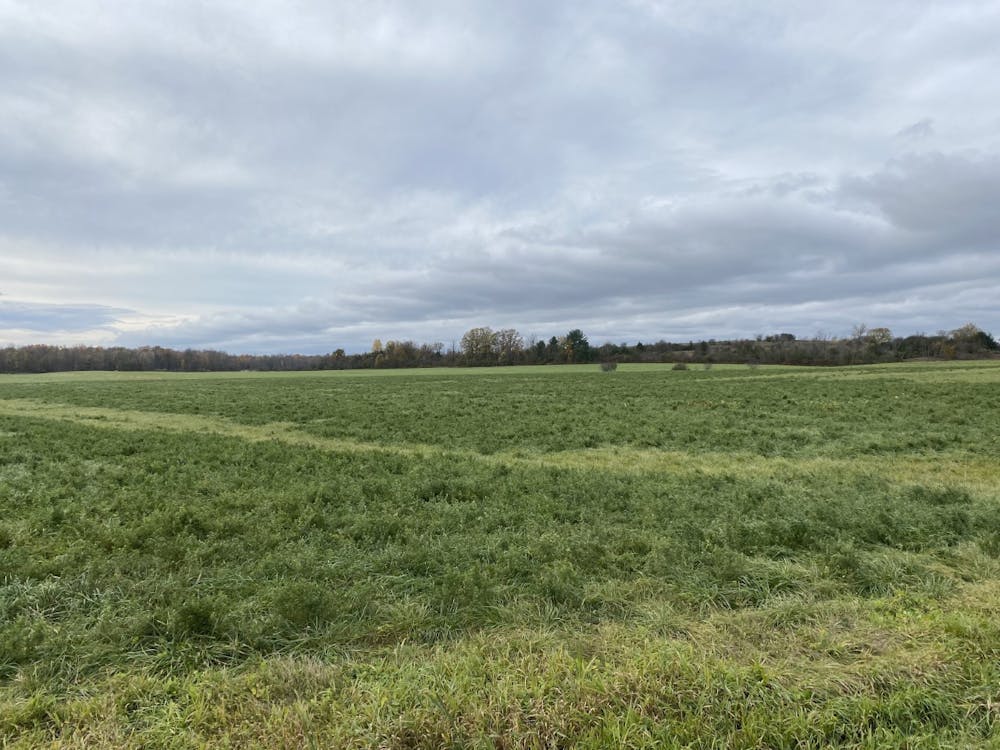Representatives from Middlebury College joined Green Mountain Power, state representatives, developer Encore Renewable Energy and the town of Middlebury at a groundbreaking event on Oct. 12 for the college’s new solar installation project on South Street Extension, which will supply 30% of its total electricity usage as part of the Energy2028 initiative for 100% renewable energy at the college by 2028.
Following the completion of construction in 2022 by Encore Renewable Energy, an expanse of field off South Street Extension a few miles from campus will be filled with the 29,000-panel solar array. While the eight other solar arrays owned by the college, both on and off campus, comprise just one megawatt of electricity, the new array will provide five megawatts, which is enough energy to avoid 7,000,000 pounds of burned coal per year.
Don Stevens, chief of the Nulhegan Band of the Coosuk-Abenaki Nation, began the groundbreaking with a blessing. Several other attendees who delivered speeches at the event included President Laurie Patton, U.S. Senator Patrick Leahy, Middlebury College Executive Vice President for Finance and Administration David Provost, Middlebury Selectboard Chair Brian Carpenter, Lieutenant Governor of Vermont Molly Gray, GMP CEO and President Mari McClure, Encore Renewable Energy CEO Chad Farrell, Greenbacker COO Matt Murphy and Simone Ameer ’21.5.
Community concerns
Originally, as announced to neighboring landowners, the project was to be located on a small ledge hill west of the current site, according to Associate Professor of Geography Jeff Howarth. Encore then moved the site to the clayplain at the north end of the Middlebury Swamp. This change was justified based on the cost of development, as the hill’s ledge rock would have been more difficult to develop than clayplain, as well as the project’s visibility from Cornwall.
The Environmental Council formed a subcommittee to assess the feasibility of a large-scale solar system in 2017, according to a statement from Jack Byrne shared with The Campus by Director of Media Relations Sarah Ray. They looked specifically at using the 10-acre site off of Rt. 125, but concluded it was not suitable.
“Later on in the process, at the request of the Town, several other sites were assessed by Encore and the site where the project is going to be located remained the best choice for the numerous criteria that had to be met for a state permit,” Byrne said in the email shared with The Campus.
Dean of the Library Mark Roy, one of the landowners neighboring where the solar project will be constructed, was “unpleasantly surprised” to learn of the site’s shift from an out-of-sight slope to being in full view.
“Some of the disappointment in terms of process was that the town and the county and the state seem not to have done any visible planning around any of this, and in the absence of a plan that the community has developed, you’re going to have private enterprise, and individual actors deciding where these things go, and the town ends up being in a kind of reactive mode,” said Roy.
While Roy and other landowners are in support of solar projects, the lack of community-based planning has left some with mixed feelings about the project.
“The lack of planning by the town puts [community members] in a tough spot in terms of how to respond when these things show up, and I think all of us who live nearby had that same conflicted relationship, because we understand the urgency of it,” said Roy. “Why wasn’t there more work to be done a decade ago, knowing that this was coming, so that we would have a plan generated by the community as opposed to a plan generated by private actors with their own particular interests?”
These types of projects are motivated by both firms and landowners looking to combat climate change and make a profit, yet landscape changes are often not considered.
“How do you plan for the landscape in conjunction with combating climate change, and not exactly pitting one against the other? It ends up feeling a bit like they’re at odds with each other, and maybe that’s the way it has to be, but maybe not,” said Roy.
Ecological impacts
There are also ecological implications of using the current site that did not factor into the moving of the site. Likely once cleared of forest for agriculture, it has been leased for hay and corn farming for several decades. The site holds some ecological value in its potential for restoration if it were not being used for the solar project.
“The state’s plan for biodiversity conservation identifies much of the low-lying area along Otter Creek in southern Middlebury, including the site of the College’s future solar array, as a high priority landscape component,” Howarth explained. This is because wetland and riparian habitat could be restored to improve the connectivity of the landscape and build resilience to climate change for native species.
According to Howarth, the original ledge hill site may have been better for development as it is not officially listed as a priority landscape by the state.
“I think the initial ledge site would have been more consistent with a commitment to plan development of College lands to achieve energy and food production for people and habitat restoration for native plants and animals as complementary rather than conflicting goals of climate change actions,” Howarth said.
College Lands Conservationist Mark Lapin worked with interns from the Sustainability Solutions Lab in summer 2018 to examine potential sites owned by the college, arriving at three locations that they recommended to the college. In the fall of 2018, Encore also completed an ecological assessment of the South Street Extension site and decided to move forward with the project there.
“Even though some of the land had been converted from wetland a century or more ago — ecologically those fields are the northern end of the stunning Otter Creek Swamps wetland complex that extends from Brandon to Middlebury, and they would naturally be forested wetland — it has long been in agricultural use and has not been ecologically functioning at high or even very low levels for many of the functions and values of wetlands,” Lapin said in an email sent to The Campus by Director of Media Relations Sarah Ray.
Lapin highlighted that flocks of sheep, rather than fuel-powered mowers, will initially manage vegetation at the site, with pollinator plants added later to help support crop production in the Middlebury area.
While pollinator gardens will surround the solar panels to enhance the ecological function of the project, Howarth points out that they seem to serve an aesthetic purpose.
“While I like the idea of pollinator gardens, I don’t think it has much to do with the location of the site, in the sense that we could be planting pollinator gardens almost anywhere. I have them in my yard,” said Howarth. “I don’t see how it justifies choosing the clayplain site for this project. I don’t see how repairing habitat connectivity in a heavily fragmented landscape to safeguard native plants and animals from climate change was part of the site selection process,” Howarth said.
Howarth also noted that there was friction between Middlebury College and the Agency of Natural Resources about the ecological function of the current site as grassland bird habitat created by agricultural clearings. This dispute presented a significant threat to the project, but was settled through mediation. The college is dedicating 95 acres of land to be managed as grassland bird habitat in accordance with state requirements.
“There’s a desire to celebrate this, which I understand completely, but I think that there was at some level very little acknowledgement of the cost,” Roy said. “We are capable of holding two different emotions in our bodies at the same time. It’s possible to have mixed emotions around this.”

Maya Heikkinen '24 (she/her) is a Copy Editor.
She has previously served as an Editor at Large, News editor, copy editor and staff writer. Maya is majoring in Conservation Biology with a minor in Spanish, but is also passionate about writing. She is from Orcas Island, WA, and loves being immersed in forests, running/hiking, gardening, and hanging with plants and cats. In addition to The Campus, she has been involved in SNEG and the currently extinct WildMidd.



